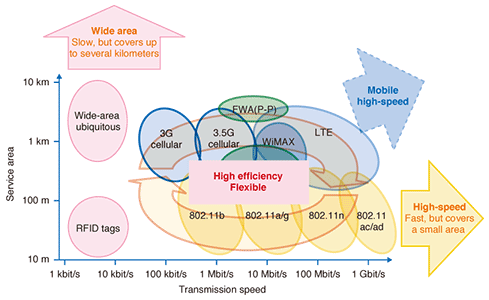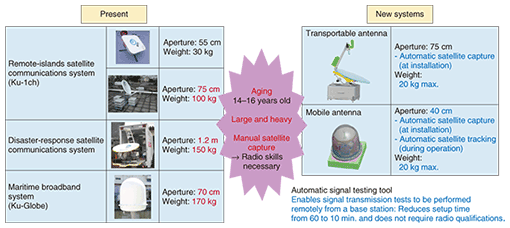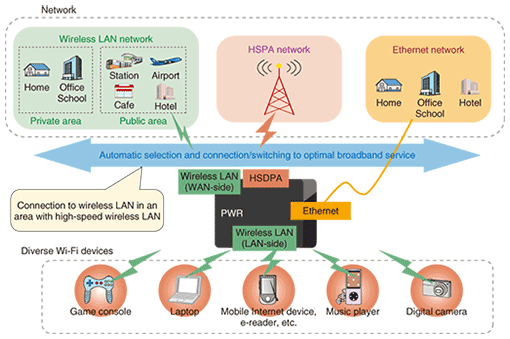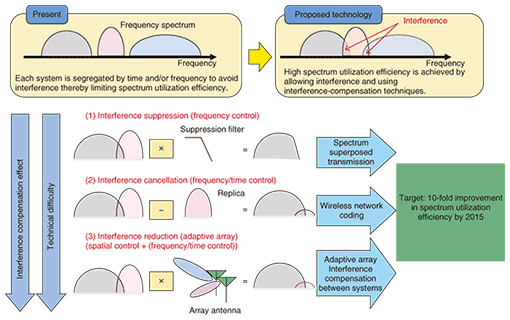 |
|||||
|
|
|||||
|
Feature Articles: NTT Tsukuba Forum 2010 Workshop Lectures Vol. 9, No. 5, pp. 29–35, May 2011. https://doi.org/10.53829/ntr201105fa4 Trends in Wireless Access Technologies toward Expansion of Broadband and Ubiquitous Services AbstractThis article introduces wireless technologies being studied in the Wireless Access Systems Project at NTT Access Network Service Systems Laboratories. To achieve flexible access networks that meet various needs or demands, the coexistence of optical fiber and wireless systems is indispensable. It also mentions electromagnetic wave propagation technology and technology for increasing frequency utilization as core technologies of wireless systems and eco-related activities that began in 2010.
1. Overview of wireless systems1.1 Comprehensive view of wireless technology R&DNTT is conducting research and development (R&D) of wireless systems and deploying a variety of wireless access services to satisfy different objectives and accommodate different types of service areas. In satellite communications, for example, we are developing technology for compact earth stations that can apply the wide-area capability of satellite communications to circuit restoration in disaster areas and technology for mobile-multicast satellite communications systems for application to maritime communications in places where the laying of optical fiber is impossible. And for rural areas, we are providing communication services using the combination of an optical fiber system (from an NTT building to a certain point) and a fixed wireless access (FWA) system (from that point to end users). At the same time, we are working on the development of a triple-play FWA system that can support quality of service (QoS) and provide video and telephony functions conforming to 0AB-J specifications (where 0AB-J refers to a 10-digit phone number starting with 0). Meanwhile, for urban areas, NTT is developing nomadic wireless access (NWA) and cognitive-radio systems that can provide high-speed wireless local area network (LAN) services in designated public areas such as airports, train stations, and cafes. Expanding the service area while keeping costs down is a problem common to FWA and NWA, but it is being solved by multihop technology that uses wireless repeaters to broaden the service area. The application of multihop technology has made it possible to easily expand wireless LAN areas that have, until now, been just spots. In addition to the above, we are developing personal wireless router (PWR) technology that enables terminals equipped with a wireless LAN function to make connections over a broad region instead of just a limited area. As a wireless LAN router that can be carried anywhere, a PWR enables a wireless LAN terminal to be used seamlessly at outside locations or at home. We are also developing ubiquitous systems (wide-area sensor network systems) for gathering information about various types of machines and facilities situated over a wide area such as automobiles, transport vehicles, and vending machines. The Wireless Access Systems Project is also researching and developing fundamental technologies in support of the above wireless transmission technologies. 1.2 Future directions of wireless technologiesThe development of wireless technologies has traditionally focused on increasing transmission speeds. The wireless LAN standard IEEE802.11, though supporting only a small area, initially specified transmission speeds of only about 1 Mbit/s but now specifies speeds in excess of 100 Mbit/s and speeds above 1 Gbit/s are under study. Greater speeds for mobile devices over broader service areas have also been pursued in system development from 3G (third-generation) cellular to Long Term Evolution (LTE). In addition, FWA has come to provide service areas several kilometers in size for point-to-point (P-P) connections and several hundred meters in size for point-to-multipoint (P-MP) connections at transmission speeds of about 10 Mbit/s in both cases. More recently, studies have been progressing on wide-area ubiquitous systems that emphasize wide-area coverage as a new technology direction separate from the pursuit of higher speeds. The wide-area ubiquitous system was born from the idea that a sensor network could be constructed by enhancing radio-frequency identification (RFID) tags and extending transmission distances. Although supporting speeds of only several kilobits per second, it features a service area several kilometers in size (Fig. 1).
2. Activities toward expansion of broadband and ubiquitous services2.1 Satellite communications systemsNTT is currently providing the following satellite communications services. - Infrastructure satellite communications system (for disaster response): maintains public lifelines in disaster areas (NTT EAST and NTT WEST) - Infrastructure satellite communications system (for remote islands): provides universal service (NTT EAST and NTT WEST) - Maritime broadband system: provides broadband communications to ships at sea (NTT Communications) - WIDESTAR & WIDESTAR II: provide satellite mobile communications (NTT DOCOMO) For each of these services, improved functionality is required to meet a high demand for smaller and more economical equipment, greater mobility, higher bandwidth and capacity, improved security, extremely wide coverage at low bit rates, and so on. To meet these needs, NTT laboratories are investigating the extension of existing services, the renovation of services, and the development of new services. (1) Compact earth station One key advantage of satellite communications is that a lifeline can be secured by simply setting up earth stations at a number of points and then connecting them via satellite. However, most of the facilities for existing earth stations are 14–16 years old while also being too large and heavy to be easily transported. Moreover, their operation requires skilled radio technicians to orient the antenna in the direction of the satellite (manual satellite capture). In response to this situation, we have developed new systems (transportable type and mobile type) that are significantly smaller and lighter. The transportable type has an automatic satellite capture function and the mobile type has automatic satellite capture and tracking functions to improve operability (Fig. 2).
The field of wireless communications is not immune to the problem of a dwindling number of technicians as the numbers of licensed radio operators is on a downward trend. As one countermeasure to this problem, we are developing an automatic uplink access testing tool. This tool enables uplink access tests to be performed remotely so that earth stations can be put into commission even by unlicensed personnel and setup time can be greatly shortened from 60 minutes to only 10. (2) Multi-domain signal processing technology The frequency band of a satellite transponder is extremely limited. In addition, as a result of the setting and releasing of channels having different bandwidths, unused frequency slots are scattered across the transponder’s bandwidth and these prevent the entire band from being used. To make effective use of such unused frequency slots, the spectrum of the modulated signal is divided into subspectra, some of which can then be purposefully removed or superposed to reduce the bandwidth required. The vertical and horizontal polarization axes can also be shared so that subspectra can be assigned as desired. The purpose of the above techniques is to improve spectrum utilization efficiency, but these techniques also have a positive side effect from the viewpoint of security. Because the spectrum of the modulated signal is broken down into fine sections before transmission, the signal cannot be correctly demodulated by a third party even if a portion of the band can be observed. This multi-domain signal processing technology enables a single satellite transponder to be shared by a disaster-response infrastructure satellite system, a remote-islands infrastructure satellite system, and a maritime broadband satellite system and enables a wide-area large-capacity system to be compact and economical while also having improved security. 2.2 FWA systemOn the basis of the current Wireless IP Access System (WIPAS (IP: Internet Protocol)), we are developing an FWA system supporting triple-play services equipped with a QoS control function including 0AB-J support and a multichannel video delivery function. For P-P (one-to-one) connections, this system will provide a maximum transmission distance of about 1.3 km and a transmission capacity of about 180 Mbit/s (total for uplink and downlink). Moreover, for P-MP (one-to-n) connections, the system will have a multicast function enabling the simultaneous provision of Internet, voice over IP (VoIP), and video services. When wireless LAN was first introduced, terminals equipped with Wi-Fi were basically limited to laptop computers and personal digital assistants (PDAs). Since then, however, Wi-Fi-certified terminals have come to be installed in a wide variety of products for diverse applications, from business to personal needs and from indoor to outdoor use. However, places where wireless LANs can be used are still basically limited to one’s home, train stations, trains, offices, and cafes. Consequently, Wi-Fi-only terminals without 3G wireless access functions cannot connect to the network from other locations. In the light of this situation, NTT Broadband Platform, Inc. has undertaken the development of a PWR as a key device for connecting to the network at any time. It can accommodate various types of Wi-Fi devices on the LAN side and features wireless LAN, high-speed packet access (HSPA), and Ethernet on the wide area network (WAN) side. It can automatically select and connect to the broadband service depending on the user’s current location (Fig. 3).
It might appear at first glance that there is no need for a wireless LAN function on the WAN side. However, including wireless LAN here, even in a terminal equipped with 3G wireless access, means that the terminal will be able to use a service that is faster than 3G wireless access when connecting at public wireless-LAN hotspot access points. In other words, it is desirable to offer wireless LAN as an optional wireless access method. Moreover, another benefit of the PWR is that it has an authentication agent function. A terminal without an authentication agent function cannot make use of a public wireless-LAN service that requires authentication. Furthermore, even if a terminal has an authentication function, the user must still follow a troublesome procedure for inputting an ID and password. The PWR eliminates this bother and enables the terminal to be used anywhere and anytime regardless of whether it implements an authentication function. 2.3 Wide-area ubiquitous systemsContrary to recent network technology trends where high-speed and large-capacity features are dominant, wide-area ubiquitous systems, though small in capacity, have been attracting attention as distinctive wireless systems that can cover a wide service area. These wide-area ubiquitous systems have the following features. - A wireless area with a radius of several kilometers - Transmission and reception of information between various types of sensors/actuators and IP terminals - Low information capacity (a few hundred bytes to several kilobytes per terminal per month) and low rates (about 100 yen per month) - Accommodation of an extremely large number of terminals (10–100 times the population) - Extremely small terminals with long lives (battery exchange required once every 5–10 years). - High security (not currently achievable by the Internet and RFID tags) Ubiquitous terminals, which excel in operability, utility, durability, and cost efficiency, can be attached to people, vehicles, measuring devices, and information appliances, and the information obtained from them can be consolidated and controlled in the system. Application examples are the reading of gas and electricity meters, stock inventory of vending machines, location recognition, determination of traffic conditions, route selection, measurement of CO2 emissions, and assessment of green measures. NTT has been holding verification trials in Special Ubiquitous Zones [1] within Tokyo as part of a three-year project beginning in 2008. In these trials, NTT collaborated with gas companies to test network connectivity (telemetry and safety) and with telecommunication operators to test terminal mobility and location accuracy (mobility and signal reachability). A wide-area sensor network consists of application servers on the user side (gas companies and telecommunication operators as joint participants in these trials), a master base station, (at Kyojima in Sumida-ku), remote base stations (Kyojima in Sumida-ku, Kanamachi in Katsushika-ku, and Chuo in Edogawa-ku), and network management equipment (NTT Musashino R&D Center) linked via an optical network. In the trial communication system, packets transmitted from wireless terminals, each about the size of a business-card case, are transferred through the optical network and the sensor network. The transmission power of these wireless terminals is very low, but the reception system composed of three remote base stations can maintain communication quality (site diversity technique). 2.4 Electromagnetic wave propagation technologyElectromagnetic wave propagation is a very important research theme in terms of equipment design, radio zone design and the establishment of core competence. In this area, questions that should be studied change as transmission speeds of wireless communication systems increase. Studies during the 1990s (1st- and 2nd-generation cellular systems) focused on receive-level characteristics, while those during the 2000s (dominated by wireless LAN and 3rd-generation cellular systems) analyzed the temporal spreading of incoming waves (differences in signal arrival times due to reflection and scattering) in addition to receive-level characteristics. Looking forward, future systems applying multiple-input multiple-output (MIMO) technology now under study (for next-generation wireless LAN and other systems) will be able to achieve high-speed and high-reliability communications by sending and receiving signals using multiple antennas and making use of complex electromagnetic wave propagation conditions in which signals arrive spatially not just from one direction but from many directions. It will therefore be necessary to analyze and model electromagnetic wave propagation characteristics that include spatially spreading characteristics in addition to studying receive levels and the temporal spreading of incoming waves as in the past. The frequency bands used for wireless communications also broaden as systems become diverse, so the propagation characteristics in various frequency bands must also be studied. Furthermore, in broadband wireless access, rainfall can cause electromagnetic waves to fade and scatter when millimeter-wave bands are used. Therefore, consideration must be given to such rainfall-related attenuation. 2.5 Technology for increasing frequency utilization efficiencySpectrum resources are limited, and effective use of the radio spectrum has been an incessant problem in wireless systems. Moreover, the 6-GHz band and below, which is suitable for mobile communications, is seriously congested and there is no way of easing this congestion other than by increasing utilization efficiency by having multiple systems share the same frequencies. The means adopted so far to enable such frequency sharing is to detect the surrounding environment and take measures to avoid interference (interference avoidance technology), which has been implemented in carrier sense multiple access/collision avoidance (CSMA/CA) and cognitive radio. However, such an interference-avoidance type of approach requires each system to be segregated in terms of time and/or frequency, which itself is limited in increasing frequency utilization efficiency. In a current study, we are looking at methods that take an aggressive approach to interference by allowing for interference in frequency sharing but removing any interference that may occur (interference-compensation frequency sharing system). There are several interference-compensation techniques as summarized below (Fig. 4).
- Interference suppression: cuts off interference power by using a suppression filter, but also reduces the power of the original spectrum resulting in slight deterioration - Interference cancellation: generates a replica of interference to subtract it from the received signals. - Interference reduction: sets up an antenna array to make an antenna beam pattern and does not receive signals in the direction of arriving interference The technical difficulty of these techniques rises in the order of suppression, cancellation, and reduction but so does the interference-compensation effect. Our aim is to achieve a ten-times increase in frequency utilization efficiency by 2015 by applying these methods. 2.6 Green wirelessWe are also working on reducing power consumption and CO2 emissions in wireless systems. One example of our efforts here is the virtual base station, which can be created by interlinking many wireless LAN access points connected by optical fiber with the aim of lowering power consumption at the system level. It is also instructive to consider that a wireless system, while providing information transfer by wireless means, must be fed power by wired means. Achieving independent power supplies for wireless systems has been said to be difficult, but we are investigating the following two techniques. (1) Wireless power transmission: Power is transmitted to wireless equipment via radio waves from a remote location, which makes power supply lines unnecessary and provides more flexibility for the equipment installation location. (2) Energy harvesting: Radio waves emitted through space such as broadcast waves are concentrated and converted into electric power for use as a power supply for wireless equipment. Alternatively, natural energy such as sunlight can be used to generate power. 3. ConclusionThe mobility, flexibility, and extendibility of wireless systems have made wireless access essential to the diverse development of access-network services. The development of wireless technologies is as crucial and significant as that of optical access technologies in the construction of a seamless network environment. Reference
ProfileCareer highlightsExecutive Manager of the Wireless Access Systems Project and the Third Promotion Project, NTT Access Network Service Systems Laboratories. Toshihiro Manabe received the B.E. and M.E. degrees from Kyushu Institute of Technology, Fukuoka, in 1985 and 1987, respectively. After joining NTT in 1987, he engaged in research on 26-GHz microwave systems. From 1990 to 1992, he was with NTT Network Systems Development Center, where he developed microwave systems connecting cell sites of mobile phone systems. From 1996 to 2002, he worked on R&D of the Advanced Wireless Access system at NTT Laboratories. From 2002 to 2006, he was with NTT Broadband Platform, Inc. developing public wireless LAN systems and services. After returning to NTT in 2006, he engaged in R&D of wireless access systems and services using wireless LAN. His activities are currently focused on the development of wireless access systems and research on wireless core technology. He is a member of the Institute of Electronics, Information and Communication Engineers. |
|||||











